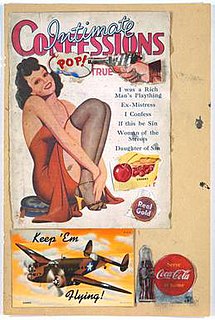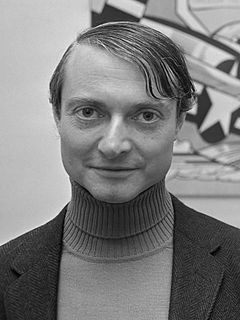The year 1956 in art involved some significant events and new works.

Whaam! is a 1963 diptych painting by the American artist Roy Lichtenstein. It is one of the best-known works of pop art, and among Lichtenstein's most important paintings. Whaam! was first exhibited at the Leo Castelli Gallery in New York City in 1963, and purchased by the Tate Gallery, London, in 1966. It has been on permanent display at Tate Modern since 2006.
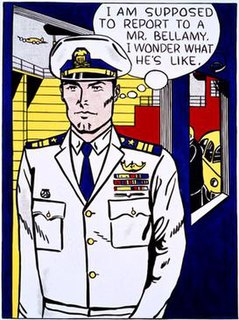
Mr. Bellamy is a 1961 pop art painting by Roy Lichtenstein in his comic book style of using Ben-Day dots and a text balloon. The work is regarded as one of the better examples of Lichtenstein's sense of humor. The work is held in the collection at the Modern Art Museum of Fort Worth.

Girl with Ball is a 1961 painting by Roy Lichtenstein. It is an oil on canvas Pop art work that is now in the collection of the Museum of Modern Art, after being owned for several decades by Philip Johnson. It is one of Lichtenstein's earliest Pop art works and is known for its source, which is a newspaper ad that ran for several decades and which was among Lichtenstein's earliest works sourced from pop culture.

Torpedo...Los! is a 1963 pop art oil on canvas painting by Roy Lichtenstein. When it was last sold in 1989, The New York Times described the work as "a comic-strip image of sea warfare". It formerly held the record for the highest auction price for a Lichtenstein work. Its 1989 sale helped finance the construction of the current home of the Museum of Contemporary Art, Chicago in 1991.

Look Mickey is a 1961 oil on canvas painting by Roy Lichtenstein. Widely regarded as the bridge between his abstract expressionism and pop art works, it is notable for its ironic humor and aesthetic value as well as being the first example of the artist's employment of Ben-Day dots, speech balloons and comic imagery as a source for a painting. The painting was bequeathed to the Washington, D.C., National Gallery of Art upon Lichtenstein's death.
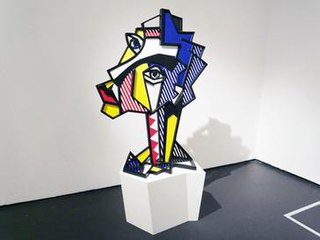
Expressionist Head by pop artist Roy Lichtenstein is the name associated with several 1980s works of art. It is widely associated with a set of six identical sculptures but is also associated with a series of paintings.
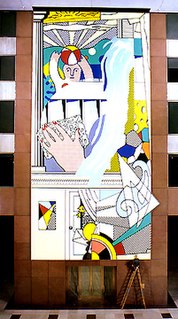
Mural with Blue Brushstroke is a 1986 mural painting by Roy Lichtenstein that is located in the atrium of the Equitable Tower in New York City. The mural was the subject of the book Roy Lichtenstein: Mural With Blue Brushstroke. The mural includes highlights of Lichtenstein's earlier works.
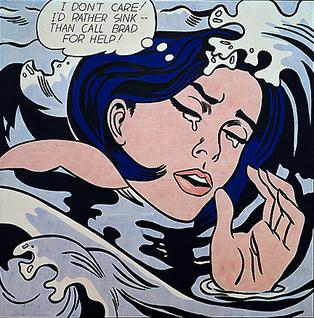
Drowning Girl is a 1963 painting in oil and synthetic polymer paint on canvas by Roy Lichtenstein. Using the conventions of comic book art, a thought bubble conveys the thoughts of the figure, while Ben-Day dots echo the effect of the mechanized printing process. It is one of the most representative paintings of the pop art movement, and part of the Museum of Modern Art's permanent collection since 1971. The painting is considered among Lichtenstein's most significant works, perhaps on a par with his acclaimed 1963 diptych Whaam!. Drowning Girl has been described as a "masterpiece of melodrama", and is one of the artist's earliest images depicting women in tragic situations, a theme to which he often returned in the mid-1960s.
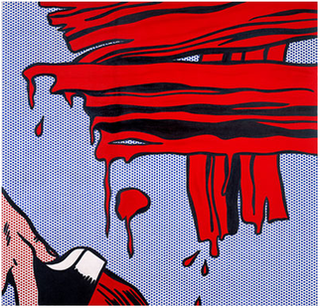
Brushstrokes series is the name for a series of paintings produced in 1965–66 by Roy Lichtenstein. It also refers to derivative sculptural representations of these paintings that were first made in the 1980s. In the series, the theme is art as a subject, but rather than reproduce masterpieces as he had starting in 1962, Lichtenstein depicted the gestural expressions of the painting brushstroke itself. The works in this series are linked to those produced by artists who use the gestural painting style of abstract expressionism made famous by Jackson Pollock, but differ from them due to their mechanically produced appearance. The series is considered a satire or parody of gestural painting by both Lichtenstein and his critics. After 1966, Lichtenstein incorporated this series into later motifs and themes of his work.

Artist's Studio—Look Mickey is a 1973 painting by Roy Lichtenstein. It is one of five large-scale studio interior paintings in a series. The series is either referred to as the Artist's Studio series or more colloquially as the Studios and sometimes is described as excluding the other 1973 painting, reducing the series to four.
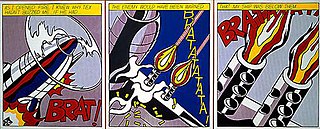
As I Opened Fire is a 1964 oil and magna on canvas painting by Roy Lichtenstein. The work is hosted at the Stedelijk Museum in Amsterdam. The source of the subject matter is Jerry Grandenetti's panels from "Wingmate of Doom," in All American Men of War, no. 90, DC Comics.

Portrait of Madame Cézanne is a 1962 pop art painting by Roy Lichtenstein. It is a quotation of Erle Loran's diagram of one of Paul Cézanne's 27 portraits of his wife Marie-Hortense Fiquet, now in the Barnes Foundation, Philadelphia. It was one of the works exhibited at Lichtenstein's first solo exhibition in Los Angeles. The work became controversial in that it led to a reconsideration of what constitutes art.

Blam is a 1962 painting by Roy Lichtenstein falling within the pop art idiom. It is one of his military comic book derivatives and was one of the works presented at his first solo exhibition. The work is in the collection at the Yale University Art Gallery.

Golf Ball is a 1962 painting by Roy Lichtenstein. It is considered to fall within the art movement known as Pop art. It depicts "a single sphere with patterned, variously directional semi-circular grooves." The work is commonly associated with black-and-white Piet Mondrian works. It is one of the works that was presented at Lichtenstein's first solo exhibition and one that was critical to his early association with pop art. The work is commonly critiqued for its tension involving a three-dimensional representation in two dimensions with much discussion revolving around the choice of a background nearly without any perspective.
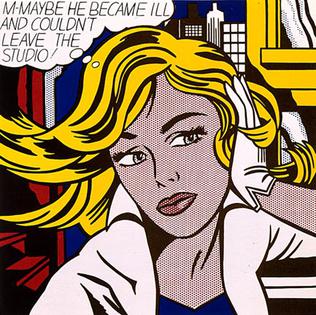
M-Maybe is a 1965 pop art painting by Roy Lichtenstein. It is one of his romance comics-based works.
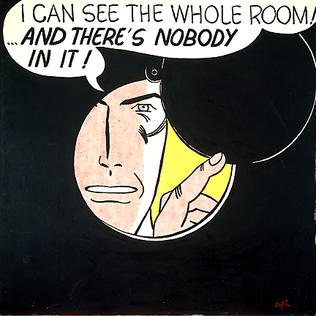
I Can See the Whole Room...and There's Nobody in It! is a 1961 painting by Roy Lichtenstein. It is a painting of a man looking through a peephole. It formerly held the record for highest auction price for a Lichtenstein painting.

Crying Girl is the name of two different works by Roy Lichtenstein: a 1963 offset lithograph on lightweight, off-white wove paper and a 1964 porcelain enamel on steel.

